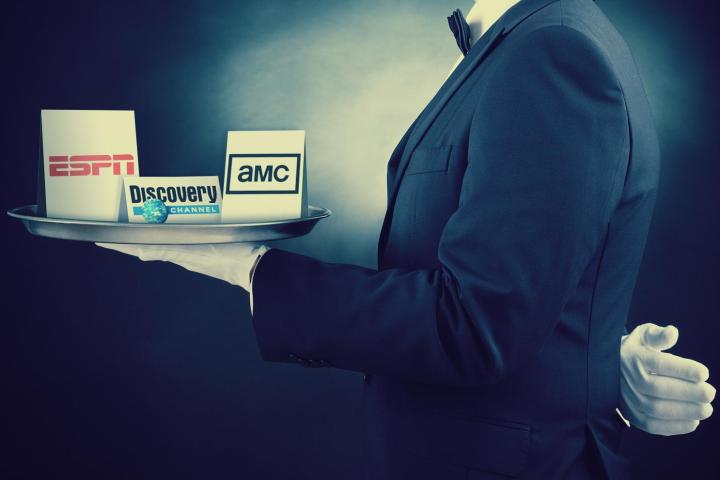
Nobody actually wants to pay for a bunch of channels they don’t watch. Yet, for years now, that’s the paradigm cable and satellite services have stuck us with: For every one ESPN, you get ten QVC’s. It’s a service model that has consumers defecting to the Internet in search of a TV utopia in which they pay only for what they want. It’s a concept that’s been branded: a la carte TV.
The act of “cord cutting”, or otherwise abandoning your cable/satellite provider, coupled with the rising interest big companies have in filling the void has led to calls for a la carte TV business models that let you pick your poison instead of paying for 500 channels you couldn’t possibly care less about. These days, it sounds a lot like a steadying outcry for better choice and fairness where even legislators in Congress are weighing in with their opinions. But a deeper look into the bigger picture shows that it may not be a cakewalk to bring down the old broken system and replace it with something freer and fairer.
The revolution has begun
The fact that TV is changing is obvious, what with services like Netflix, Hulu and Amazon Instant Prime growing their subscriber bases and delving into producing their own exclusive content. In turn, Big Media, like the cable companies and networks, are trying to keep from losing out in this existential power struggle over who the power-brokers will be in the future of TV.
“Most channels are owned by the same handful of large media companies that seek to maximize revenue across all of their channels”
Even Republican Senator John McCain took it upon himself to co-sponsor a bill (with D-Conn Senator Richard Blumenthal) that would basically force pay-TV operators to offer a la carte deals. The bill seems a long shot to pass, but it has helped cast a spotlight on the angst consumers feel about what they pay to watch the limited programming they tune into every week.
Despite McCain’s assertions that the government and special interests have “stacked the regulatory deck in favor of preserving an outdated business model”, it will still prove to be a tough nut to crack.
The money behind cable deals
“Most channels are owned by the same handful of large media companies that seek to maximize revenue across all of their channels,” says Greg Ireland, a research manager at IDC who follows the industry. “By bundling channels, they’re able to get carriage fees and advertising revenue on channels that perhaps wouldn’t get carriage if offered on their own. This model, while problematic for some consumers (and some pay-TV operators), isn’t broken from the media company perspective and they don’t necessarily want to make changes that upset the current formula.”
Channel survival has long been cited as a key reason why an a la carte system would be detrimental to both the pay-TV operators and consumers. Channels that appeal to niche audiences or minorities might have a tough time staying on air because of the current benefits of bundling channels together. Those opposed to a la carte believe content diversity, such as it exists today in an albeit flawed system, would suffer greatly because of the lack of choice it brings with it. An older example of a successful crossover was Queer Eye for the Straight Guy, which was aimed at a specific audience, but became an Emmy-winning series that launched on Bravo, a channel that many consumers might not have considered subscribing to at the time.

But the Internet was still evolving at the time, and there was no Netflix, Hulu or Amazon Instant Prime back then to provide an alternative to pay-TV for shows with more of a niche audience. As the political drama House of Cards showed for Netflix, original content can work wonders, and the continued success of such projects might open the door to more content aimed at a smaller percentage of subscribers.
In many ways, TV channels were already doing that years ago. Shows would be exclusive to a network or specialty channel until they were farmed out for syndication to subsidiary channels or local broadcasters. The trend later on took this a little further, with exclusive shows like Mad Men or Breaking Bad on AMC and The Vampire Diaries on The CW as two examples of popular shows that started with smaller networks.
Those shows can be found on Netflix, and while they don’t air the newest episodes, their availability already opens the door to expanding that offering in the future. But that won’t happen without a fight.
Why TV can’t change overnight
“Media companies can’t simply walk away from revenue and profits without there being some consequences,” says Ireland. “It could very well be that the result of a la carte is that many consumers will end up paying the same amount for fewer channels. But this doesn’t mean there can’t or won’t be possible solutions — smaller bundles and different price points, or perhaps bundles without expensive sports-centric content. Choice is good for consumers but many times things don’t work out exactly the way we wish them to.”
He adds that there is a lot of good programming on TV right now because many channels are investing in higher quality original content (like Mad Men and Breaking Bad). Subscription fees go, in part, to supporting the creation of that content — as well as the stuff that isn’t particularly good. “The magic question is where the tipping point is in terms of consumer appetite for higher bills and action from Washington or the courts,” he says.
“Media companies can’t simply walk away from revenue and profits without there being some consequences”
“Traditionally when customers complain pricing is too high, the company feels the pinch and cuts the price, but cable television isn’t a two-part system,” says Kagan. “Instead, it’s a three-part system. If customers complain to the cable company, they aren’t complaining to the only party that matters. The third party is the networks who always charge more, year after year.”
Part of the reason they do is because the talent also wants more. In fact, a lot of stakeholders have to get paid. Complaining about the cost of accessing content might directly relate to what it costs to produce a show and what actors and actresses in hot shows are demanding for pay raises. A good example is Friends, where all six regular cast members wanted $1 million per episode. That, along with more elaborate shooting locations and larger crews, has likely contributed to this trickle-down effect.
“If the cast of Modern Family goes on strike demanding higher wages, that can trickle down, just like with the high-profile demands of the cast of Friends and for sports programming costs,” says Ireland. “So consumers that clamor for a la carte need to understand that, for better or worse, depending on one’s perspective, there’s a bigger business model that results in the situation we now have and there are many parties on which to place blame if we’re looking for someone to blame.”
Calling it a “broken model” that is essentially unsustainable, Kagan believes the current system protects pay-TV companies and punishes customers unfairly. Regulators back in the day never could’ve imagined this scenario when the system was first set up, but reforming it now will require some trade-offs on all sides.
Are actors or actresses willing to take a pay cut? Will pay-TV operators slowly phase out niche and specialty channels? Will those channels then move to streaming online to connect with their audience, and if so, is that audience willing to pay $5 per month for just one channel?
What a la carte TV might look like
“A la carte is an open market where some networks would thrive and others would suffer because the customer chooses, meaning that little watched channels would struggle,” says Kagan. “But what’s missing is that the industry has to come up with another model that will reward both investors and customers. Today, a subscription is twice what it was 10 years ago, and it will double again in another decade, so the cable industry is spinning out of control. That’s the reason people are crying out for a less expensive alternative and why a la carte makes sense to a growing segment of consumers.”
The current system and a la carte are undoubtedly very different business models, and it may take some time to figure out how everyone, especially you as a consumer, come out of it with what you want for less of your money. In an a la carte world, the price per channel may be more than it is today, but since the average viewer sticks to about five or 15 channels per month, the total bill should theoretically be much lower.
It would be great to add and subtract channels at will as part of your subscription, but pay-TV operators are scared to death of such a scenario because of the loss in revenue that would come with that. And since there are investors with big dollars in the mix, change won’t come easily or swiftly. What happens to the “little guy” channels will be a sidebar to the wider story, but for the time being, change will be a slow dance between frustrated customers and anxious pay-TV operators looking to do business as usual.



